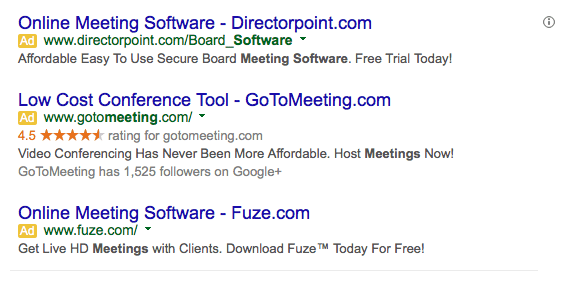A well-managed Google Ads account can drive tons of valuable traffic to your website. If it’s not handled with care, however, your Ads account could quickly turn into a marketing initiative that ends up costing you more than it brings in.
In this post, I’ll outline the 5 most common mistakes we’re seeing companies make when it comes to Google Ads account management, and offer some tips that could help you avoid these common pitfalls and help ensure that you’re getting the highest possible return on your investment in paid search.
Mistake #1: Not utilizing keywords in your ad copy
Not using keywords in your ad copy is like trying to drive your car while it’s in park… You won’t get very far!
Google calculates an “Ad Rank” to determine your ads’ placement in the search results. While Google determines your Ad Rank by looking at several key auction-time quality components, one of the biggest quality components that affects your Ad Rank is ad/search relevance.
If the text in your ads contain keywords that are relevant to what people are searching for, then you can help improve the quality components of your Ad Rank. Higher quality ads can often lead to lower cost per click (CPC) and higher conversions.
Recommendation: Always, always, always include one of your main keywords in your ad copy or header. Be careful to not overdo it with using keywords in your ad copy though. Google frowns upon the practice of “keyword stuffing.”
Mistake #2: Not having a targeted call to action
In a pay-per-click (PPC) ad, your call to action is extremely important since it tells searchers what to do after they’ve read your ad.
A person who searches for something online is usually trying to solve a problem or get an answer to their question. From an advertiser’s perspective, think of your ads as being the solution to the person’s problem. Once you know their pain-points, wants, needs, and desires, your ad can speak to that need and encourage them to take action.

When your PPC ads show up in the search results they need to achieve 2 goals:
1. Tell potential customers that your product or service is the solution to their problem, and
2. What action they should perform to get your solution.
Recommendation: Develop a clear, targeted call to action to use in your PPC ads. Be sure to let potential customers know exactly what action they should take by using relevant, action-oriented verbiage (e.g. “Shop Now” or “Sign Up Today”). However, avoid using the phrase “Click Here” because that is a direct violation of Google’s advertising policies (and they will disapprove your ad).
Mistake #3: Not adding negative keywords to your campaign
If you’re like me you wouldn’t drive down the street throwing money out of your windows (but in the off-chance that you would do this, then please let me know when and where you will be driving).
This is what happens if you’re not using negative keywords in your campaigns. Negative keywords are keywords that prevent your ads from being displayed when people search for a particular word or phrase. Adding negative keywords to your Ads campaigns improves your ads’ chances of being displayed to searchers who are most likely to click on them and can help you get the most clicks from your ad budget.
Recommendation: Determine the keywords and phrases that do not define the products or services being marketed in your ads. If you’re a women’s shoe store that only sells flats and heels, for example, then you wouldn’t want your ads to show up when people search for “women’s sneakers” or “women’s athletic shoes.”
Visit the Google Ads Help Center to learn more about how to add negative keywords to your campaigns.
Mistake #4: Not effectively utilizing ad groups
Ad groups are designed to help group your keywords and ads based on similar themes. Lumping all of your keywords into one ad group and showing everyone the same ad is not an effective paid search strategy and may end up costing you clicks, leads, and dollars. Showing the same ad to people searching for different keywords could mean thousands of wasted impressions.
We often see accounts that are set up with little or no structure to their campaign and ad group, and this is one of the biggest mistakes people make when it comes to Google Ads account management.
Recommendation: Build out ad groups as specifically as possible by merging similar keywords and ads into in different ad groups. For example, if my business is a women’s shoe store that also sells accessories, I may want to set up my campaigns and ad groups as follows:
Women’s Shoes (Campaign)
Boots (Ad group)
Heels (Ad group)
Flats (Ad group)
Sandals (Ad group)
Women’s Accessories (Campaign)
Scarves (Ad group)
Bracelets (Ad group)
Necklaces (Ad group)
Headbands (Ad group)
Rings (Ad group)
Purses (Ad group)
As you can see from the campaign example above, each ad group represents a different product category. I would make sure that I only added keywords and text ads that are specific to each particular ad group. And if you were paying attention to the previous section, we may even want to add “women’s heels” as a negative keyword to the Flats ad group to ensure that ads from my Flats ad group are only triggered when someone searches for “women’s flats.”
Mistake #5: Not setting goals or establishing budget
Before you even consider setting up an Ads account for your business, make sure you’ve defined your goals and established an appropriate budget. It’s very easy to overspend in Google Ads, especially if you’re new to Ads or are running separate campaigns that target different geographic regions.
Setting the goals you want your campaign(s) to achieve prior to creating an account will help you determine your initial ad spend. Once your account is up and running, you can adjust your budget to capitalize on new opportunities and challenges arise (for example, a very high cost per click for a particular keyword that you really need to target).
Recommendation: Define the goals of your campaign and establish a budget long before running any paid search ads. Since your overall marketing budget and expected return on investment are important factors, this is especially critical if your company is engaged in other forms of advertising. Fortunately, Google Ads allows you to designate exactly how much you want to spend so you can easily set a budget that is reasonable for your business.
Avoid the Common Pitfalls in Google Ads
There you have it folks, a list of the 5 most common mistakes most companies are making with their Google Ads account. Obviously, there are many other elements that can cause your campaigns to fall short of their full potential and end up costing you time, money, and even new business.
If you’re using paid search to get found online and want to maximize the return on your investment, then contact us today for a digital marketing assessment.


